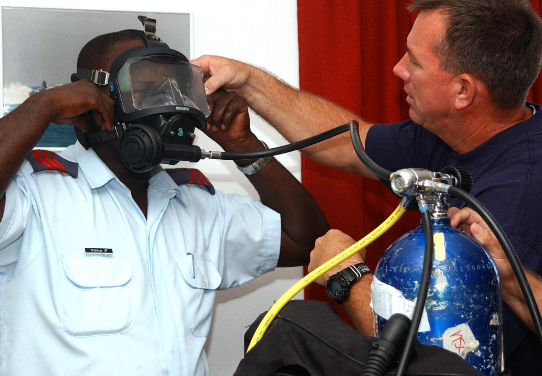When it comes to scuba masks, one should remember that Full Face Scuba Masks are not normally used for recreational use. The only exception is if you plan to dive in cold waters. Cold water divers usually wear them to help stay warm. That’s why Full Face Masks are used in the commercial diving sector as well as by many underwater videographers. Their use is for the ability to fit radio communication units that allow for free communication between divers. If the underwater videographer is filming for a t.v show then the audience will be able to hear what’s going on. Here are a couple of details to keep in mind prior to choosing a Full Face Mask.
Difference Between Full Face Masks and Regular Scuba Diving Masks
The main difference is that the Full Face Diving Mask completely seals the diver’s face from the water. It also includes a mouthpiece that can be connected to allow breathing. This means the second stage regulator is connected as part of the full face mask. This eliminates the divers need to hold the regulator with their teeth to keep it in their mouth. This makes it a more comfortable dive experience in comparison to a half face mask.
Full Face Masks are considerably more bigger and heavier than their conventional counterpart. It requires a diver to receive more special training prior to its use underwater. Outside of the extra training, there is nothing to really worry about because the Full Face Masks are secured with head straps so the chance of the them coming off is zero. Plus, the Full Face Mask seals are airtight which also decreases any risk of water leaking inside of it while diving. As compared to half-masks, Full Face Masks can be up to four times more in price. This is why it is very important to make sure you are willing to make such an expensive investment.
Things To Keep In Mind when Choosing a Full Face Mask
- Make sure you know the type of diving you are going to be using your Full Face Mask for. If you’re going to be in simple cold water, your best bet would be the basic full mask which will give you basic protection. If you plan on communicating underwater, there are different types that are better fitted with underwater transceivers.
- Make sure to try on a few models to find the most comfortable Full Face Mask for your face. Also make sure you wear a hood while trying them on, so you can get the full feel of the mask.
- Do a thorough inspection of the silicon that surrounds the mask to make sure there are no gaps visible. While trying it on slide your finger against the outer part to check for any gaps that may be present between your face and seal.
- When checking for a good fit, simply nod and shake your head a little to see if it shifts on your face. Then gently push the Full Face Mask upwards on your chin to ensure the snugness of it.
- Next, turn your eyes to the left and right to check for the peripheral vision and your range of visibility. Checking this will prepare you for any murky water you might dive into.
- The last thing to check for is the mask’s surface air valve located on the side. Full Face Masks aren’t designed for snorkeling but if you are near the water surface, it should allow surface breathing.
Tags:Miami scuba full face mask




